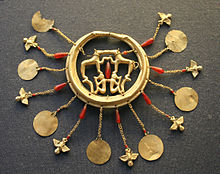Aegina hoard
The Aegina Hort ( Greek Θησαυρός της Αίγινας ; English Aegina Treasure ) is one of the most important Minoan gold finds. It was discovered on Aegina and has been in the collection of the British Museum in London since 1892 .
Discovery and Exploration
The hoard was reportedly found in a tomb on the island of Aegina in 1891. The exact circumstances of the find could never be determined. In 1892 the British Museum bought most of the treasure from the Cresswell Brothers, a London-based sponge trading company. In 1914 more pieces of the treasure were purchased.
Arthur Evans suspected that they were pieces from the Geometric Period and dated them to the 9th to 8th centuries BC. However, when the famous bees of Malia - a golden pendant - were discovered in the necropolis of Chrysolakkos near Malia in 1930 , similarities to the Aegina hoard were recognized. Since then, the pieces in the hoard have been considered Minoan products. Some researchers even suspected that the treasure originally came from the necropolis of Chrysolakkos and only found its way to England via Aegina. The most recent excavations at Cape Kolonna in Aegina City, however, uncovered similar pieces of jewelry, so that Aegina is once again considered a site of discovery today.
description
The Aegina hoard consists mainly of gold jewelry, which, based on the style and iconography , is dated to the end of the Middle Minoan or the beginning of the Late Minoan period (1800–1550 BC). It includes two pairs of decorated earrings, three tiaras, a pendant, a necklace, a gold cup, four rings, ornate fittings and smooth gold stripes. There are also five bracelets or rings and many pearls and fittings made of different materials such as gold , lapis lazuli , amethyst , quartz , carnelian and green jasper .
Individual evidence
- ^ British Museum Collection.
- ↑ Gold pendant from the Aigina treasure.
- ↑ Arthur Evans: A Mycenaean Treasure from Aegina . In: The Journal of Hellenic Studies . No. 13 , 1971, p. 195–226 ( Textarchiv - Internet Archive - reprint of the 1892/93 edition).
- ^ British Museum.
literature
- Frederick Henry Marshall : Catalog of the Finger Rings, Greek, Etruscan, and Roman, in the Departments of Antiquities, British Museum. British Museum, London 1907, p. 115 (no. 690–693) and p. 145 (no. 888) as well as panels XVIII and XXIII.
- Frederick Henry Marshall: Catalog of the Jewelery, Greek, Etruscan, and Roman, in the Departments of Antiquities, British Museum. British Museum, London 1911, pp. 51–56 (no. 683–768 and additions A – E) and plates VI – VII.
- Lucilla Burn: The British Museum Book of Greek and Roman Art . Thames & Hudson, London 1992, ISBN 0-500-27657-9 .
- Reynold A. Higgins : The Aigina treasure reconsidered . In: Annual of the British School . 1957, p. 42-57 .
- Reynold A. Higgins: The Aegina Treasure . British Museum Press, London 1979, ISBN 0-7141-8006-8 .
- Claus Reinholdt: The early Bronze Age jewelry hoard from Cape Kolonna . Publishing house of the Austrian Academy of Sciences, Vienna 2008, ISBN 978-3-7001-3948-5 .
- J. Lesley Fitton: The Aigina Treasure. Aegean Bronze Age Jewelry and A Mystery Revisited . British Museum Press, London 2009, ISBN 978-0-7141-2262-5 .
